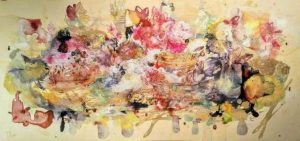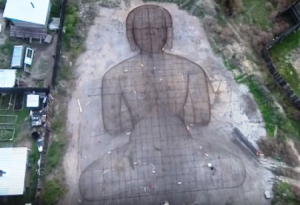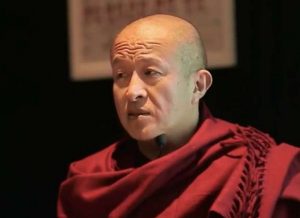Jaune Quick-to-See Smith is an Indigenous artist and a member of the Salish and Kootenai Nations in Montana. Her rich art shows a wide range of subject matter, inclusive of joy and lightheartedness, as well as the dark depths of suffering, historical and ongoing. Her work is complex visually and politically, and yet as the viewer I felt drawn in, never alienated. I wanted to understand more about her experience, her vision in relation to the natural world, ancestors, cultural traditions, and our modern society. I found her work to be paradoxical, heartbreaking, yet full of hope and potential. Throughout her many decades as an artist, Smith has also been an art teacher and an activist. She influences younger and older generations in vital ways. Even now, in her 80s, she continues to impress and is quite prolific in her creation of artwork.
Her work is currently on display at the Whitney Museum of American Art in New York City, offering an impressive recognition for her work, long overdue. She recently said that she could only ever imagine partaking in the group show Venice Biennale, never imagining she would one day have a solo retrospective. Having just encountered her artwork, I felt a great sense of joy for Smith, and for me to be exposed to such meaningful activist art. As the artist states of her younger days:
While working as a full-time artist, I also consistently organized and curated exhibitions for Native artists for over 30 years. One of my most memorable was the first touring Native women’s exhibit: Women of Sweetgrass, Cedar and Sage. After receiving the catalog, one woman wrote me that she laid the catalog against her cheek and cried. She had no idea there were so many Native women artists out there and she no longer felt alone.
(Brooklyn Museum)

As an engaged Buddhist, I find it imperative to interact with artists and works that explore what it means to be fully human and alive today. Addressing such conundrums as the “meaning of life,” how humans hurt one another, and what awareness is; how awareness includes both ultimate and relative levels, intertwined, is one facet of the arts. Art has the power to transcend these two levels and interweave them, leaving the viewer or experiencer to absorb and metabolize what they will. This is a form of meditation in action and compassionate activity—to listen, to observe, or to hold space for dialogue with viewpoints familiar or foreign to us, holding them in positive regard. It is a way of looking both backward and forward in a linear timeline held within the mandala of timeless time.
If the path of meditation is to transcend or liberate all from suffering, it is not a practice we engage merely for our own benefit. Engaging with the arts as a maker, viewer, listener, or participant is a form of meditation in action, where compassion for oneself, others, and our cultural systems are embraced in our bodhisattva vow. This encompasses all possible human emotions—anger and confusion, joy and sorrow—giving us a tangible path to walk in communicating our needs and desires, our hopes and failings. As we wish to know others better through their expressive means, we strive to understand and therefore care for them—and all relations, i.e., sentient beings—in ever more skillful ways.

As the exhibition materials state:
Smith’s work persistently draws attention to the fact that indigenous peoples exist and flourish in the United States, despite centuries of attempted erasure by waves of European invaders, subsequent generations of white settlers, and the policies of the federal government. She feels strongly that her works should, in her words, “leave an imprint on the land that says we are here. We have been here, and these are our stories. These are my stories, every picture, every drawing is telling a story. I create memory maps.”
(Whitney Museum of American Art)

Much of Smith’s artwork combines painting, collage, lithographs, and mixed media to convey the interrelationships of her people with the land, the elements, animals, and the experiences her people and the Earth continue to face under cultural repression and brutality. The way Smith incorporates humor, satire, and multi-layered meanings, as well as forms, imagery, and colors, give her work a truly unique and expressive style. Smith’s “driving concerns [are]: ecological disaster, the misreading of history and the genocide of Native Americans, but also the restorative power of kinship and education. Rejecting a strict chronology, the exhibition instead offers moments to discover the linkages between Smith’s images and ideas across time.” (Whitney Museum of American Art)
I have traveled extensively in the world and seen art in many places. But one thing I almost never do is take part in a guided tour of a museum exhibition or gallery. I suppose I’ve always thought that I would rather let the works speak for themselves, to make their impression upon my heart, mind, and visual senses without someone elses’s commentary. However, in Smith’s show, there was a tour underway, and I overheard the guide giving extensive and fascinating commentary on the works.
He—and, in fact, all the guides—had obviously been educated directly by the artist about what she wanted verbally conveyed about her work. I was riveted by the talk. As we moved through the gallery, the guide spoke at length about four different works of art, encouraging questions from the group, engendering a lively and deep conversation. This was yet another opportunity for me to learn something about my own learning style and my preset notions. In the future, I will pay more attention to the option of an excellent guided tour. It feels liberating to cut through one’s own limiting beliefs!

Employing satire and humor, Smith’s art tells stories that flip commonly held conceptions of historical narratives and illuminate absurdities in the formation of dominant culture. Smith’s approach importantly blurs categories and questions why certain visual languages attain recognition, historical privilege, and value.
(Whitney Museum of American Art)
After viewing about 80 per cent of the exhibition, far more than I predicted, I descended in the elevator to the lobby, ready to leave the museum. One of the docents asked me if I would do an exit survey. I was happy to oblige. She asked many questions about my experience at the museum and of the Smith exhibition, which was the only one I saw. There were several other compelling exhibitions, but I could not add anything more to my emotional or mental palates. And in fact, I did not want to disturb the mood I had been left in through experiencing Smith’s moving and impactful work.

It was, and remains, an emotional journey, delving into her experience even a little bit and letting it penetrate through the layers of my ignorance and tenderness around the issues of genocide, cultural erasure, and the dominance of one culture over another. Since I belong to the typically dominant white culture, it takes effort to engage with such bodies of work that bring up a painful collective past. Although I am committed to, and deeply interested in, the Indigenous activist arts, it takes energy to engage with challenging material. Thus, self-care and replenishment are required. I did not want to mix up my mind with any other artists or viewings that day, but simply to rest in the deepened awareness and appreciation for Indigenous voices and creativity. This prolific and impactful artist Jaune Quick-to-See Smith, with her very apt name, is an artist to seek out. Educational art such as hers stands out as a much-needed antidote to the nonsense pervading US political culture today in terms of further erasure of vital voices, Indigenous among them, who ought to be seen, heard, recognized, and appreciated for their unique human being-ness.

See more
Jaune Quick-to-See Smith (Brooklyn Museum)
Jaune Quick-to-See Smith: Memory Map Apr 19–Aug 13, 2023 (Whitney Museum of American Art)
Jaune Quick-to-See Smith: Memory Map (YouTube)
Exhibition Tour | Jaune Quick-to-See Smith: Memory Map at the Whitney Museum of American Art (YouTube)
Related features from BDG
Indigenous Art Matters – The Bold, Contemporary Work of Artist Gregg Deal
Still Standing: Resistance and Resilience of the Standing Rock Sioux Nation
Restoration and Justice: An Interview with Dr. Natalie Avalos on Indigenous Spirituality and Buddhist Allies
Buddhistdoor View: Indigenous Relations – Restoration and Restitution















